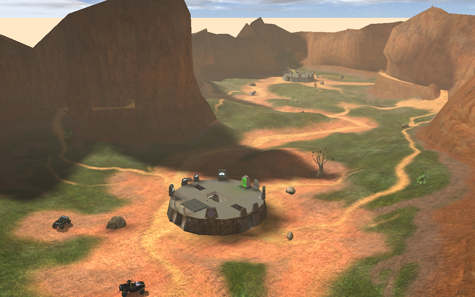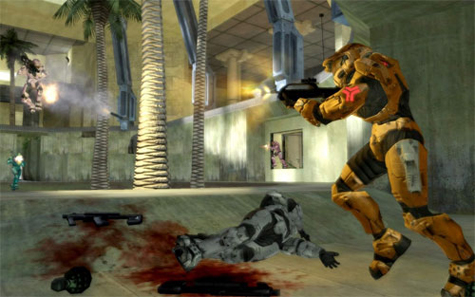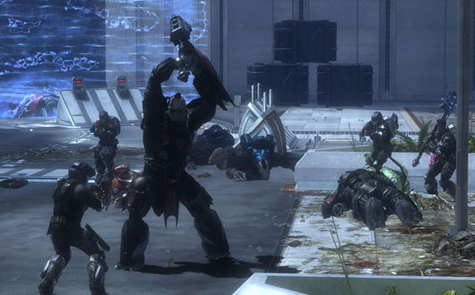This post has not been edited by the GamesBeat staff. Opinions by GamesBeat community writers do not necessarily reflect those of the staff.
Editor's note: Michael looks at how the quest for balance changed the feel of the Halo series, and how the Reach beta's Invasion mode looks like a return to form for the franchise. It was definitely a hit at our most recent Game Night! -Demian
"Everyone, stick to the plan!" my teammate urges as the match begins. We all know the drill by now, though, a mere two days into the Halo: Reach beta, well enough to instinctively hop over the railing, mash the left bumper to sprint forward, and fire off our supplies of grenades the second the game starts.
One-flag Capture the Flag on Sword Base, the azure map with multiple levels and ramps, plays out the same way every time. The flag's defenders have little choice; they can wait until our grenade bombardment lets up and hope they're not too late, or go around the back way, allowing us to steal their precious flag, though flanking us in the process. Few teams choose the latter strategy.

Games on Sword Base unfold the same way, every time.
This is, technically, a very balanced experience. The red and blue teams take turns defending and attacking, always spawning in the same locations, usually with the same armor abilities. Attackers choose sprint to get to the flag quickly. Defenders choose armor lock, the temporarily impenetrable shield, to survive the avalanche of grenades. Once the flag makes it out into the main courtyard of the level, which rarely takes long, members of each team fall back to the tried-and-true, jetpack-enabled Airborne loadout.
The attackers attempt to launch the flag into their base using the gravity lift, which may or may not have been its original purpose, and the defenders attempt to shoot them. Respawners redouble the grenade spam, and clusterfucking ensues.
It's difficult to defend the flag, but it's also difficult for the attacking team members to carry it all the way to their base, even with the (perhaps unintentional) advantage provided by the central grav lift. (For some reason, I like to imagine that developer Bungie envisioned players running, pack-like, through the level's cramped corridors, working together and checking around every corner, rather than spamming grenades into the middle of the level while the flags floats up and down helplessly. If that's the case, their vision was, sadly, not achieved.)
Regardless, this experience is a far cry from those halcyon days of Halo: Combat Evolved. This is the complaint most frequently leveraged against Bungie's beloved franchise, and even discounting the heady influence of nostalgia, the detractors have a point.

My formative years were spent right here.
When the original Xbox's sci-fi green, quasi-holographic dashboard greeted my 13-year-old eyes for the first time, I was mesmerized. When Captain Keyes handed me that fabled pistol, I hardly knew how to thank him. Getting the feel for the new controller, innovative game mechanics, and unearthly graphics was an incredible experience, one made infinitely better by the fact that I shared it with my closest friends. Though technically young, we were hardened veterans of the frenetic battlefields of GoldenEye and Perfect Dark, and thanks to Halo's multiplayer, making the transition from Nintendo's trusted quirks to Microsoft's unexplored frontiers wasn't as hard as we had feared it would be. We were lucky trailblazers.
Our favorite map was, of course, Blood Gulch. We'd spend the match's opening moments firing pistols slugs at one another while scrambling toward the Scorpion Tank in an all-out race for supremacy. Whomever controlled the tank controlled the entire level.
The first of us to reach it usually headed for the hills — literally — jamming the Scorpion behind the elevated rocks at the far end of the canyon, raining military-grade death down on anyone and everyone who dared move. The others, like those left behind at the Rapture, tip-toed through the shadows and clambered up the hill, intent on toppling the Scorpion God, lest more judgments crash down from on high. These efforts were usually in vain, and matches often ended with vast differences in scores.

The Battle Rifle eliminated experimentation.
It was fun to watch on the Scorpion God's portion of the screen as you bobbed up and down between the gulch's hills, brashly attempting to reach the rocket launcher and fire off one desperate shot before oblivion arrived via the tank's main cannon. Equally fun was teaming up, if only temporarily, to man a Warthog and distract the tank with errant chain-gun fire and tenacious meandering long enough for a fourth player to get the jump on him. Experimentation was the name of the game, and this proved true on all maps, through single-player and multiplayer, in every game type and every scenario.
Something happened, though, during the creation of Halo 2. Balance came to the fore at the expense of experimentation, and the three-round-burst Battle Rifle joined the fray. All players were equal, provided they didn't try to pick up any other weapon. The masses of Xbox Live and the elitists at Major League Gaming controlled the tides of gameplay, influencing updates, weapon tweaks, and matchmaking playlists — elements that hadn't even existed a few years earlier. Vehicles were gimped by the rocket launcher's shiny new lock-on feature, and the 'Gulch, remade as Coagulation, was an over-sized mess.
Though the return of Halo's Assault Rifle boded well for Halo 3, the same issues persisted in multiplayer. It was fair for every player; it was difficult for one team to gain a distinct advantage, and it truly wasn't as fun as it used to be. It's hard to articulate where the magic went, but for fans, the difference was palpable. Halo 3: ODST's Firefight mode went miles in the right direction, though spotty connections and a lack of matchmaking (my friends and I live worlds apart by now, after all, and we rarely have similar schedules) made it ineffectual, a blip on the radar.

Firefight, though excellent, was largely overlooked.
Halo: Reach may be Bungie's last chance to recapture some of that old magic. The first few days of the multiplayer beta, which began on May 4, demonstrated that they were certainly trying. The Internet wept at the removal of the Battle Rifle, though many players shed tears of joy. Its replacement — the DMR — is a far more subtle weapon, capable of great damage but with numerous weaknesses. That's as it should be.
Something was still awry, however, and it struck me as my friends and I — the same ones I devoured the original Halo with over eight years ago — stormed the Sword Base's flag for the umpteenth time.
"This is not why I play Halo," I said, half aloud.
"What?" responded my friend.
"This is not why I play Halo," I reiterated. The discussion that followed led to a revelation. After years as a Halo fan — the kind that reads the books and scours the Wiki, not the MLG kind — I could finally put into words some of what I had been feeling for years. I missed the experimenation. The discussion ended with a pang of hope, however, as the following day Bungie's true ace in the hole, Invasion mode, was due for release.

Elites and Spartans are no longer evenly matched.
Invasion pits Spartans against Elites in a three-part game of Territories-meets-Capture the Flag. Spartans desperately try to hold their ground as the agile, powerful Elites storm a simple complex from either side. The Spartans eventually retreat into a larger base, with new objectives to defend against the Elites before either team can claim victory.
Players are no longer evenly matched; Elites now possess a versatile dodge maneuver, allowing them to negotiate an advantage against Spartan players in almost any face-to-face confrontation. Spartans possess generally superior weapons and vehicles, however, and the equipment in play becomes more lethal as a match progresses. In the end game, energy swords and grenade launchers replace plasma rifles and DMRs, and vehicles, including that good old Scorpion Tank, spawn in for extra chaos.
Teamwork is important for both sides but especially for Elites, who must decide whether to storm the Spartans' base guns blazing or opt for the more stealthy Assassin loadout. During the final phase of most matches, players have a huge range of choices. Spawn far from the action and hop in a vehicle, or ask your teammate to kindly find a quiet corner so you can join the game at his or her side?
Elites can choose the deadly energy sword, the long-range needle rifle, the plasma rifle, or the needler. Spartans have an even harder decision between the DMR, Shotgun, Grenade Launcher or Assault Rifle, each with different armor abilities. Players must attack and defend multiple objectives, only some of which must be completed for the game to continue. Strategies are endless; teamwork, wit, and yes, experimentation, win matches.
Invasion is what I've been looking for all these years. Halo has come a long way, and I would have never guessed that it would take an experience so vastly different from the original game to finally achieve a similar feeling. If Bungie can deliver even more come September, Reach may be the actual Halo-killer the industry has been seeking for so long. Is it balanced? Sometimes. Is it perfect? No — and thank God for that.